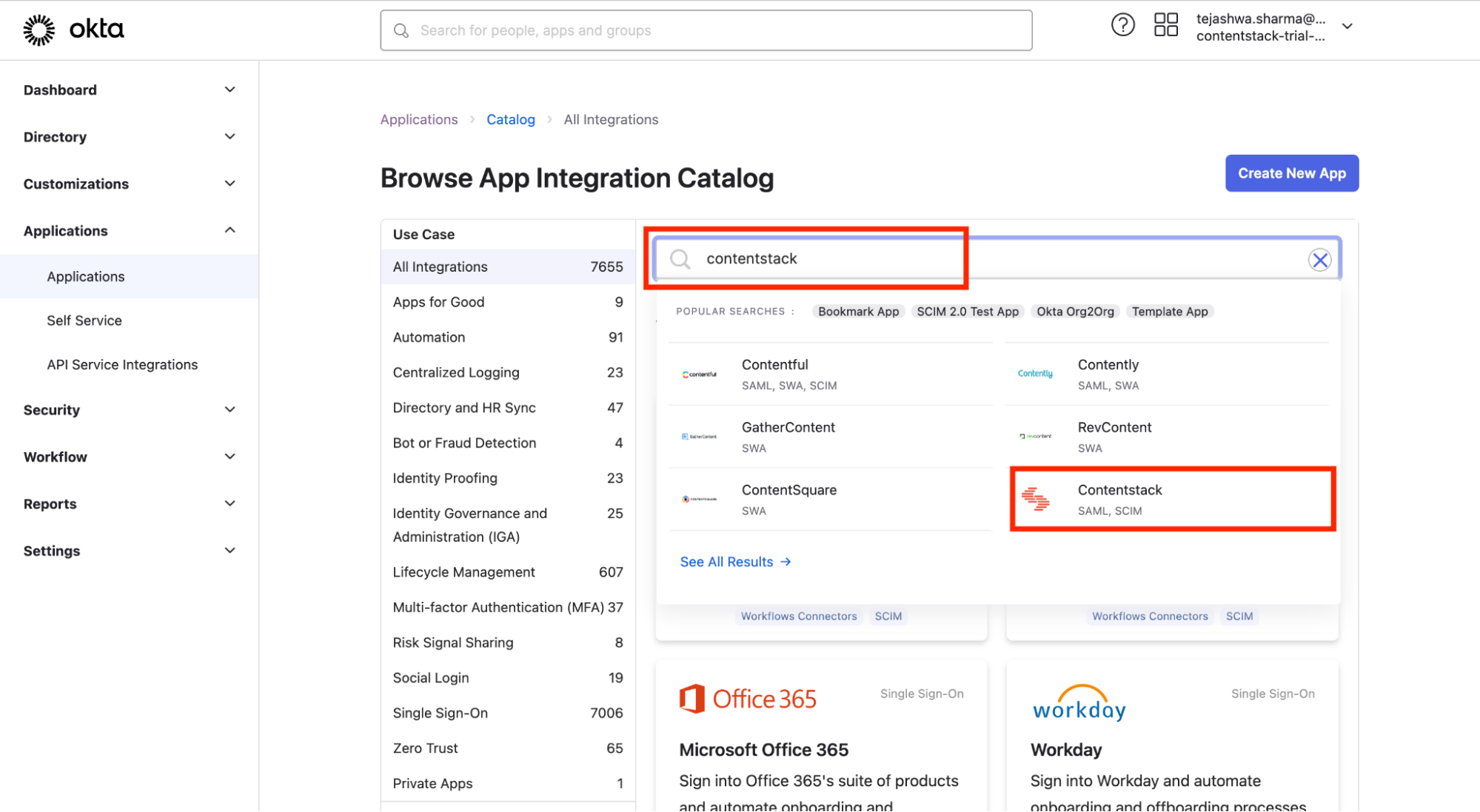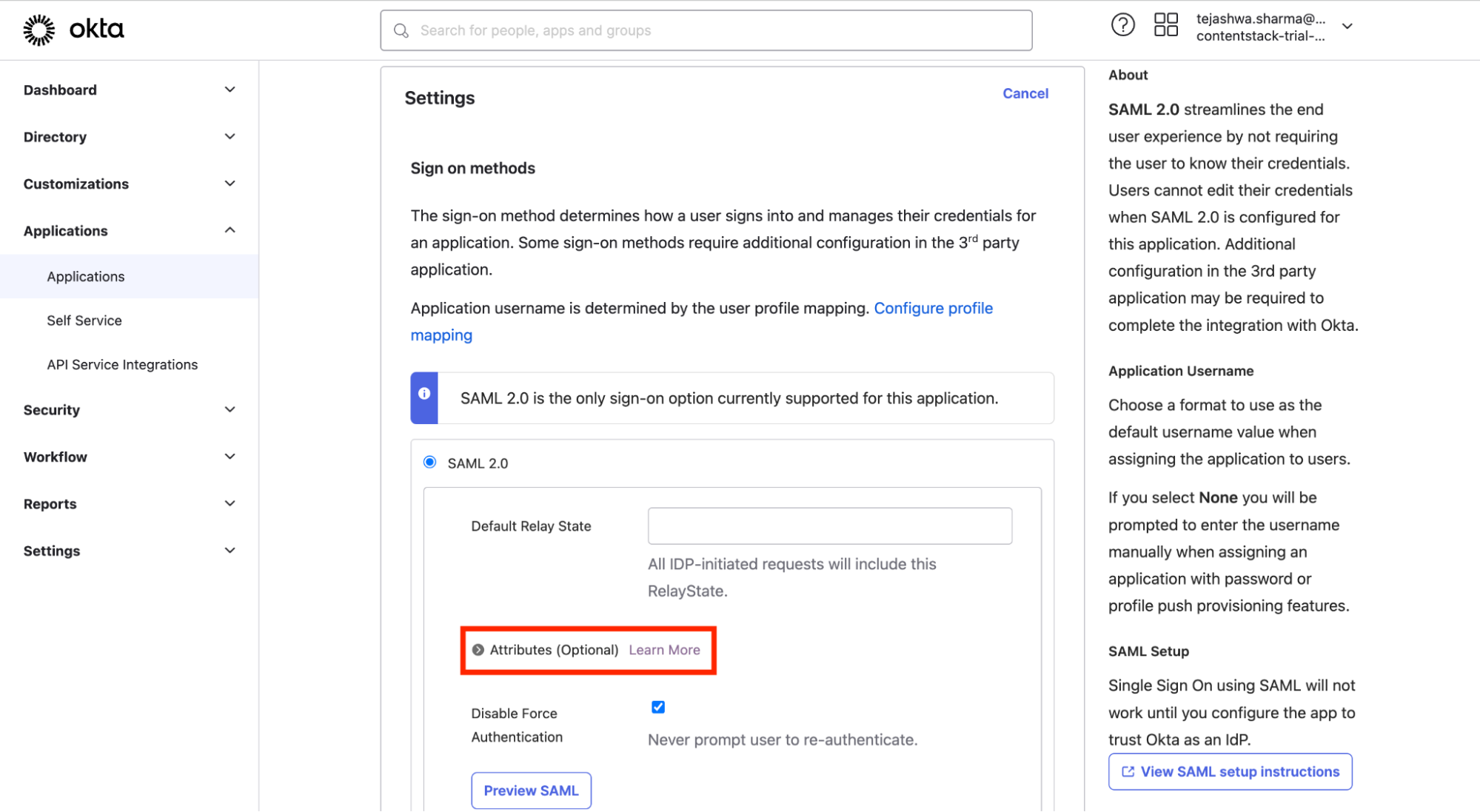Set up SSO with Okta Native App
This step-by-step guide explains how to set up Single Sign-On in Contentstack with Okta as your SAML 2.0 identity Provider (IdP).
The integration with Okta can be done in following easy steps:
- Create SSO Name and ACS URL in Contentstack
- Configure Contentstack App in Okta
- Configure Okta details in Contentstack
- Manage users access control in Okta
- Create Role Mappings in Contentstack
- Test and Enable SSO
Supported features include:
- SP-initiated (Service-Provider-initiated) SSO
- IdP-initiated (Identity-Provider-initiated) SSO
- Just-In-Time provisioning
Let’s see each of the processes in detail.
Create SSO Name and ACS URL in Contentstack
Log in to your Contentstack account, go to the Organization Settings page and click on the SINGLE SIGN-ON tab.

Enter an SSO name of your choice, and click Create. For example, if your company name is “Acme, Inc.” enter “acme” here. This name will be used as one of the login credentials by the organization users while signing in and cannot be editable later on.
Note: The SSO Name can contain only alphabets (in lowercase), numbers (0-9), and/or hyphens (-).

Let's use “sso-test” as the SSO Name.
This will generate Assertion Consumer Service (ACS) URL and other details such as Entity ID, Attributes and NameID Format. These details will be used in Step 2 for configuring the Contentstack app in Okta.

Keep this window open, as you may need these details for setting up the Contentstack app in Okta.
Configure Contentstack App in Okta
- Log in to your Okta Admin account.

After logging in, you will see the Okta dashboard. Click on the Application tab and select Applications.

In the Applications page, you will see your already created applications, if any.

Click the Browse App Catalog to set up an application for Contentstack.

Search for “Contentstack” within the Browse App Integration Catalog section and select the Contentstack app.

You will be redirected to the Contentstack application. Click on the Add Integration button.

You can edit the Application label as per your preference and click on Done.

You will be redirected to the application’s configuration page. Locate the Sign On tab and click the Edit button.

In the Settings section expand Attributes to add any additional attributes (Optional).

Optionally, you can create role mapping. To do this, in the Group Attribute Statements (Optional) section, enter the following:
For Name, enter “roles” Name.
Under Name format (optional), select Unspecified.
For the Filter, select Matches regex and enter your regex term in the textbox beside it. For example, if all your Contentstack specific users are assigned roles that start with contentstack, enter the regex term ^contentstack.([^\s]+)*.
This will retrieve all the groups that start with "contentstack".

Note: Perform this step only if you want to enable IdP Role Mapping.
In the Advance Sign-On Settings, enter the following details:
Assertion Consumer Service URL: Enter the Assertion Consumer Service (ACS) URL that you created in Contentstack in Step 1.
Entity ID: Enter the Entity ID of Contentstack, from step 1, typically represented as https://app.contentstack.com.
Application username format: Select the Email option
Update application username on: Select Create and update

Click Save.
- Log in to your Okta Admin account.
Configuring Okta details in Contentstack
In Okta, click the Sign On tab of the application that you created in Step 2 and then click More details.

Copy the Sign-On URL and Download the Certificate.

Go to the Contentstack Single Sign-On settings page, and locate the IdP Configuration tab. Enter the Sign-On URL that you copied in the previous step in the Single Sign-on URL field.

Upload the X.509 certificate that you downloaded from Okta, into the Certificate field in the 2 IdP Configuration section in Contentstack.
That’s it! Now, let’s see how to assign your Contentstack application to your users in Okta.
Manage users access control in Okta
After setting the necessary configurations in Contentstack, you need to now assign the newly added application to your users.
Add application to users
Go to the Assignments tab of your application,click the Assign dropdown, and select Assign to People.

You will get a list of registered users to whom you need to assign your application. Click the Assign button beside the user to whom you want to assign the application, and click Done.
Also, you may use multiple applications assignments available under Applications > Assign applications menu.
With this, you are done with setting up the Contentstack app in Okta. Proceed to configuring the remaining steps in Contentstack SSO in Step 6.
But, if you want to perform IdP Role Mapping and allow user groups to directly log in to your SSO-enabled organization (without invitation) with the assigned permissions through role mapping, perform Step 4.2.
Add application to user groups for IdP Role Mapping
Perform this step only if IdP Role Mapping is part of your Contentstack plan.
IdP Role Mapping is an alternate way of managing users and permissions of your SSO-enabled organization. This feature allows you to map your IdP roles to Contentstack roles while configuring SSO for your organization.
Go to the Assignments tab of your application, click the Assign dropdown in the application details section, and select Assign to Groups.

You will see a list of registered groups. Click the Assign button beside the group(s) to which you need to assign your application. Click Done.
You can now proceed to create role mappings in Contentstack for the IdP roles you created. Go to the 3. User Management section of your Contentstack SSO settings and perform Step 5.
Create Role Mappings in Contentstack
In the User Management section, you will see the following steps:
Strict Mode: Enable Strict Mode if you do not want any users to access the organization without SSO login.
Session Timeout: The Session Timeout option lets you define the session duration for a user signed in through SSO. While the default is set to 12 hours, you can modify it as needed.
Advanced Settings: Click on the advanced settings to expand the IdP Role Mapping section to map IdP roles to Contentstack.
In the Add Role Mapping section, click on the + ADD ROLE MAPPING link to add new IdP role mapping and enter the following details:
IdP Role Identifier: Enter the IdP group/role identifier, for example, “Contentstack Developers”. This should be the same as the name of the group assigned to the application on Okta.
Organization Role: Assign either the Admin or Member role to the mapped group/role.
Stack Roles (optional): Assign stacks as well as the corresponding stack-level roles to this role.

Likewise, you can add more role mappings for your Contentstack organization. To add a new Role mapping, click on + ADD ROLE MAPPING and enter the details.
Keep Role Delimiter blank as Okta usually returns roles in an array.
Finally, check the Enable IdP Role Mapping checkbox to enable the feature.
Click Next to continue further.
While some details about these steps are given below, you can refer to our general SSO guide for more information.
Test and Enable SSO
Next, you can try out the “Test SSO” and “Enable SSO” steps in Contentstack
Test SSO
Before enabling SSO, it is recommended that you test the SSO settings configured so far. To do so, perform the following steps:
Click the Test SSO button and it will take you to Contentstack’s Login Via SSO page, where you need to specify your organization’s SSO name.
Then, click Continue to go to your IdP sign in page.
Sign in to your account. If you are able to sign in to your IdP, your test is successful. On successful connection, you will see a success message as follows:

But, if you have enabled IdP Role Mapping, you’ll find the following details in a new page:
SSO connection established successfully - A success message is displayed.
IdP Roles received - The list of all the roles assigned to you in your IdP.
Contentstack-IdP role mapping details - The details of all the Contentstack Organization-specific and Stack-specific roles mapped to your IdP roles.
Click on the Close button. Now, you can safely enable SSO for your organization.
Note: While testing SSO settings with IdP Role Mapping enabled, the test will be performed only for the IdP roles of the currently logged-in user (i.e., the Owner performing the test).
Enable SSO
Once you have tested your SSO settings, click Enable SSO to enable SSO for your Contentstack organization.

Confirm your action by clicking on Yes.
Once this is enabled, users of this organization can access the organization through SSO. If needed, you can always disable SSO from this page as well.

Log In via SSO
To log in to Contentstack via sso, perform the steps given below:
Go to the Contentstack App and click the Via SSO button.

Enter your SSO Name (created in step 1.2).
Click on Log In.





.svg?format=pjpg&auto=webp)
.svg?format=pjpg&auto=webp)
.png?format=pjpg&auto=webp)






.png?format=pjpg&auto=webp)